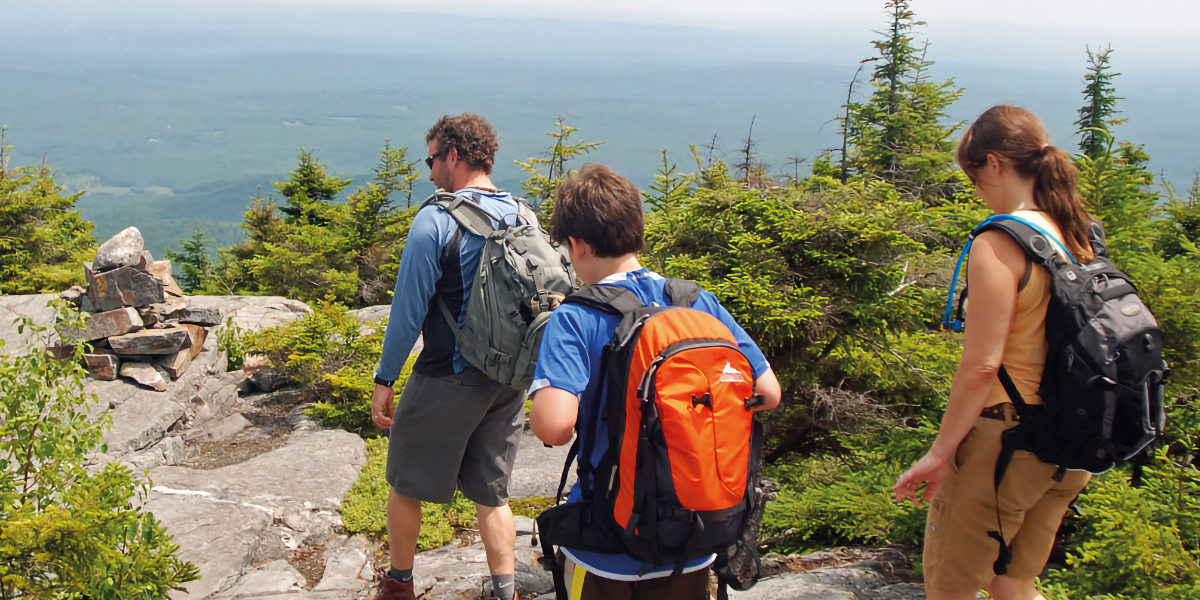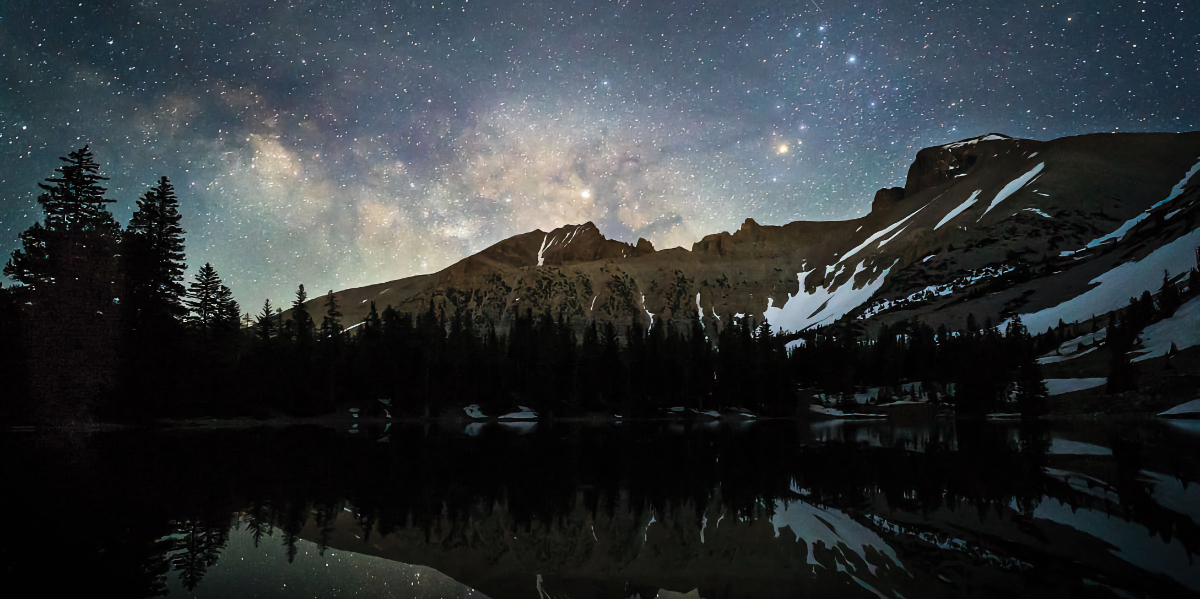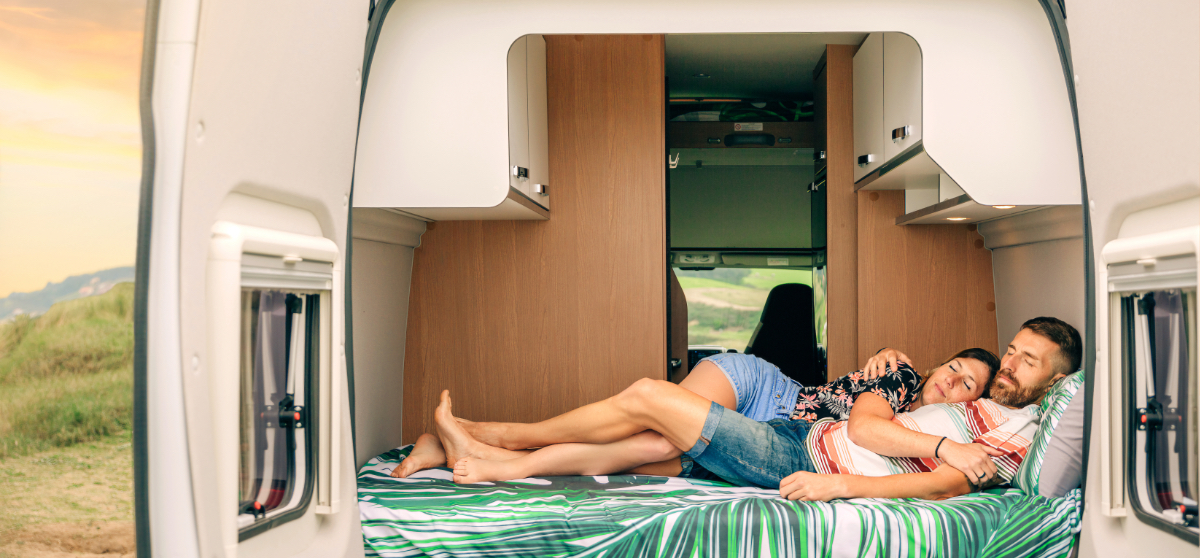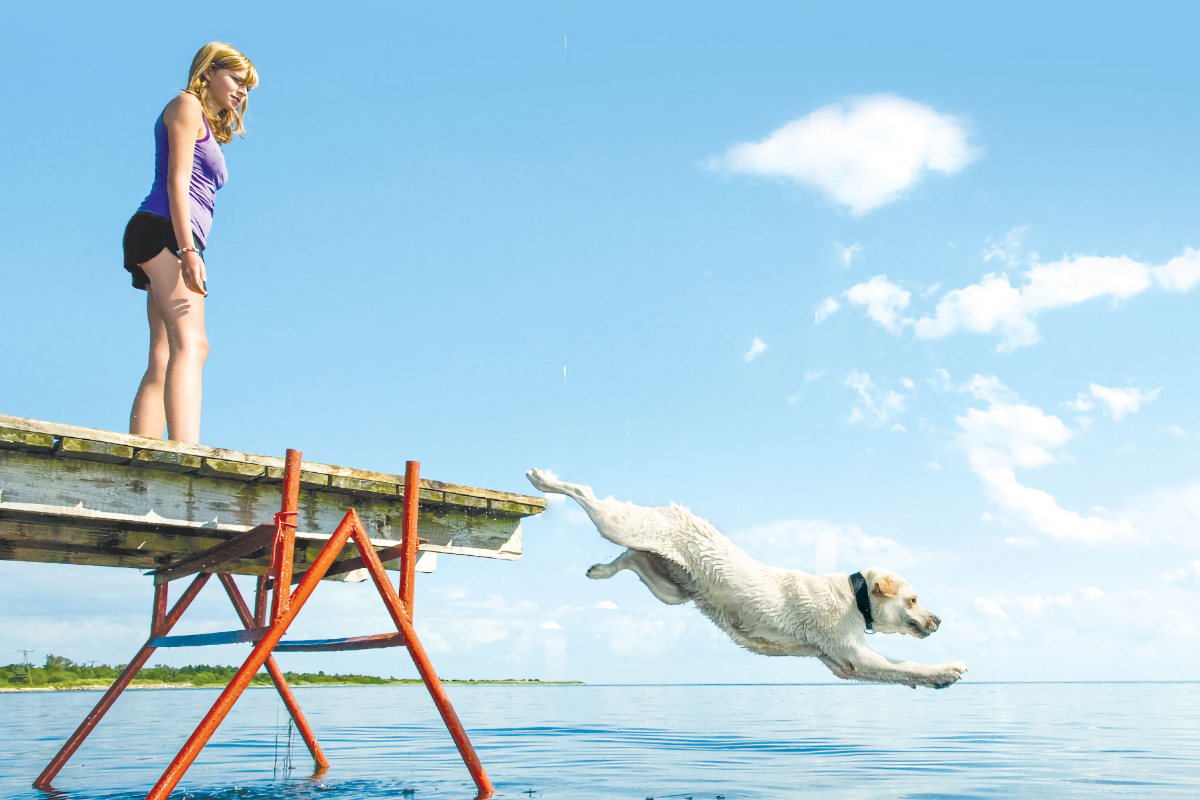Winter Camping in the Yukon
Image Caption:
There are strange things done
In the midnight sun
By the men who moil for gold.
The Arctic trails
Have their secret tales
That would make your blood run cold….
-Robert Service, “Bard of the Yukon”
As a reasonably rational and recently retired sportswriter who blew out 68 candles on his last birthday, I would never have planned a winter camping trip to Canada’s Yukon territory and would have scoffed at the mention of it. Retirees are supposed to morph into snowbirds and spend the winters in warm climates such as Arizona, Belize or Machu Picchu but not next door to Alaska in sight of the Arctic Circle where the thermometer plunges to minus-40 degrees Celsius (coincidentally, minus-40 degrees on the Fahrenheit scale) sometime between the equinoxes (September 20 to March 20), possibly for an extended time.
In fact, my only son, a 36-year-old Whitehorse geologist who gave me three good reasons to spend the summer camping in the Yukon — aged 7, 5 and 3 — believed it was not possible.
I agreed it wasn’t smart, but anything is possible if you set your mind to it and approach it with the right attitude. The more he told me it couldn’t be done, the more I wanted to do it, not necessarily to prove him wrong but mostly out of curiosity. I wanted to see if it was possible to outfox Mother Nature. It sounded more interesting than turning into Jimmy Buffet and running for mayor of Margaritaville on some Caribbean beach.
The Plan to Camp in the Yukon
My plan was very simple. The Inuit spent thousands of years defeating the winter forces of nature by building igloos out of ice and snow. All I had to do to win the game was to turn my little R-pod trailer into an igloo, which it sort of resembles anyway. When I told my son my plan, he shook his head sadly, as if he was digesting his dear Daddy’s dementia for the first time, and said with a resigned chuckle, “Well, take a lot pictures so we can display them at the funeral.”
Plan A was to literally build an igloo out of blocks of snow around the trailer, covering everything but the windows and door and furnace intake/exhaust, but Yukon snow is usually so dry you can’t even roll up a decent snowman with the kids. It’s more like sugar, which meant I would have to build forms and add water to get a solid building block, and I would be at the mercy of the chinooks all winter, even if I was successful. Chinooks, also called Pineapple Express, are sudden Pacific lows that come from Hawaii several times every winter and warm up all of northern Canada, usually well above freezing. A weeklong chinook would make my igloo/trailer look like a Slurpee in a microwave, so I went to Plan B, which was Styrofoam.
A local Whitehorse building-supply company, Kilrich, had a fire sale on some great insulation called Enviro-Shield that got partly damaged in its yard by a windstorm.
Materials needed for Winter Yukon Camping
I picked up enough to igloo the whole trailer for $290, including some 3-inch-thick insulation to skirt the bottom all around, which is crucial to keeping out the cold. The skirting went so well and made such a difference in the warmth of the floor, it made me wonder if I even needed to bother covering the whole thing, so I postponed putting it on but kept it handy in case I started losing the battle and needed it to get to spring. As the snow increased over the winter, I would just keep piling it up against the outside walls with a shovel at no cost, minimal labor and maximum insulation. Nothing insulates better than snow, and it disappears in the spring when you’re done with it.
All of that was the Outside Plan, and it was solid, but the Inside Plan was more important because inside is where I planned to live in comfort for the winter, and my definition of comfort is not complicated: If it’s warm enough inside to read, write, sleep and eat dressed in nothing but boxer shorts and a T-shirt, bring on the margaritas. If I have to wear long johns, wool socks and a hoodie inside to stay warm, make some adjustments. It was easy to gauge success or failure on that score without using the Frostbite Factor. I kept meticulous track of how long a 5-gallon propane cylinder lasted.
The goal for the long winter was to make a jug of LP-gas last a month by insulating the outside and taking the pressure off the furnace inside with small ceramic space heaters, which I purchased for $30 each at Canadian Tire. With those strategically placed, one pointed at the bed, one at the thermostat and one under the kitchen table, it was just a matter of watching the temperatures drop during autumn and making small adjustments as it got colder.
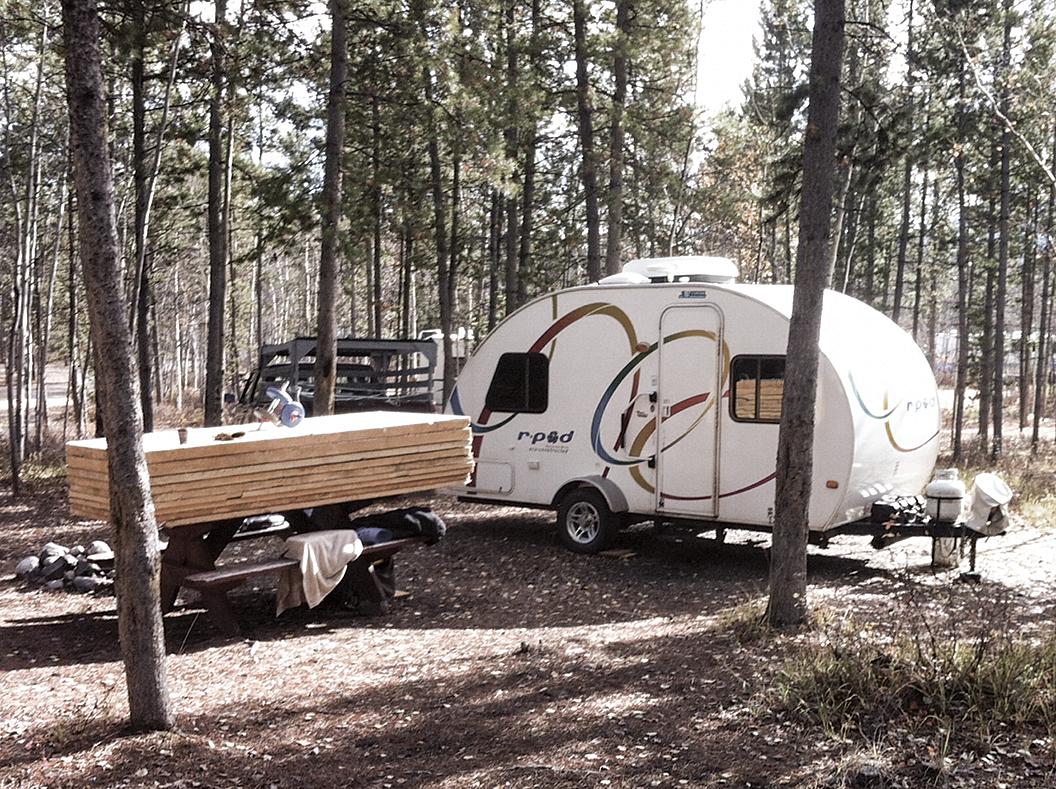
Most of that pile of insulation ended up in the geologist’s backyard waiting for future construction projects. Photos by Doug Sack
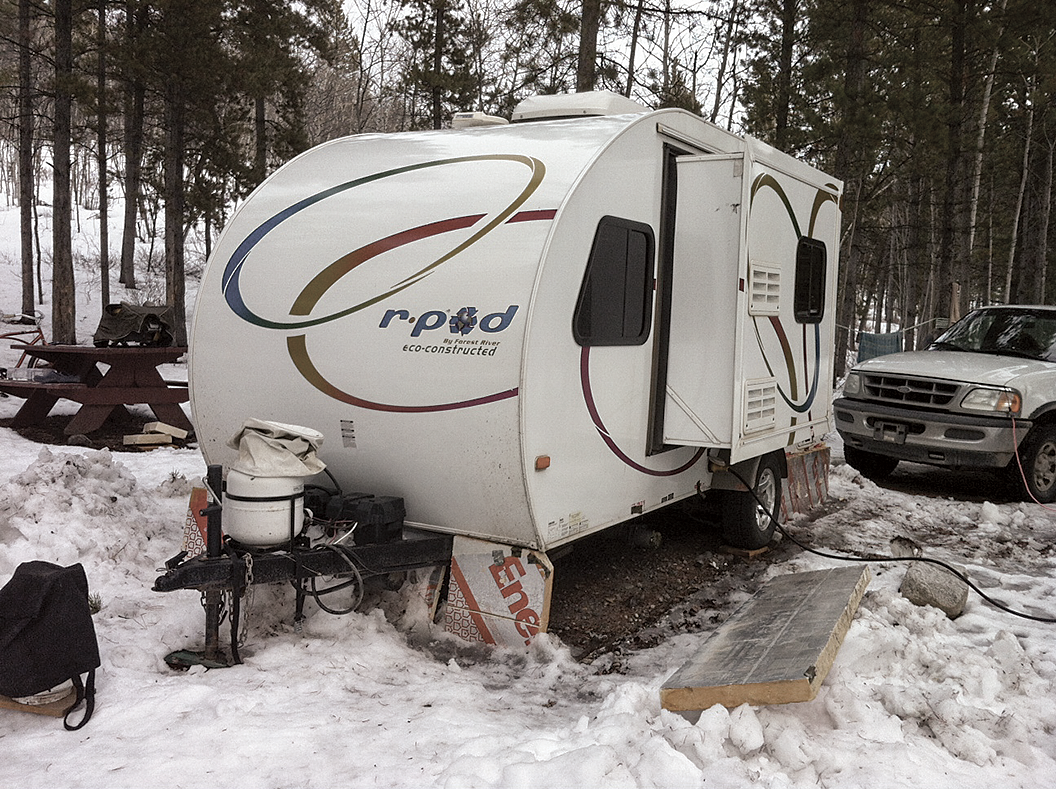
It took only two sheets, 3 inches thick, to skirt around the bottom and hold Mother Nature at bay — with a little help from three space heaters, 10 jugs of propane and a lot of snow.
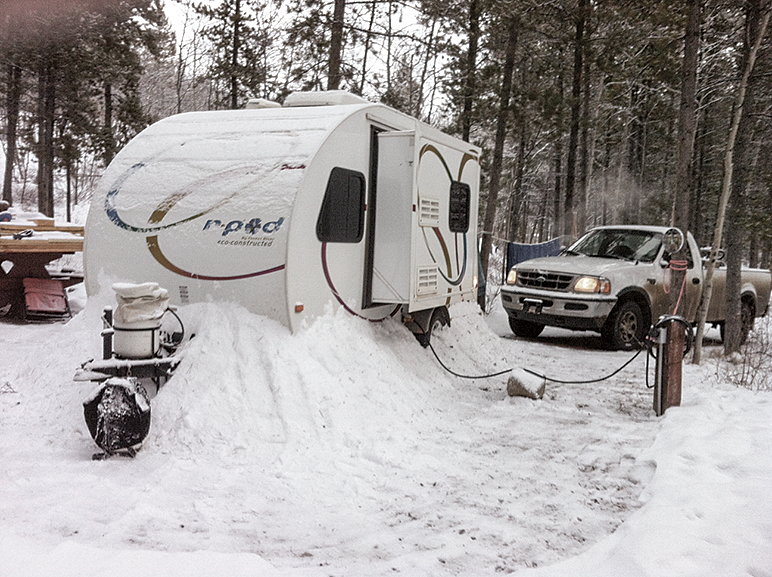
The aging sportswriter snuggled warmly inside his igloo on New Year’s Day.
Gauging the Cold
When the first cold snap arrived the last two weeks of November, dropping the thermometer to minus-26 degrees C (minus-15 degrees F), I started to learn things about my plans and whether I was going to flourish or freeze when minus-40 degrees C came to town surfing the North Wind.
For instance, at minus-10 degrees C (14 degrees F), the space heaters kept the inside of the trailer warm enough, and the furnace was dormant. At minus-15 degrees C (5 degrees F), I got a burn ratio of 30:1, which means the furnace needed to burn for two minutes to keep me warm for an hour; at minus-20 degrees C (minus-4 degrees F), the ratio was 5:1, and at minus-25 degrees C (minus-13 degrees F), it was 2:1 or 30 minutes of furnace burn for an hour of warmth. These numbers, which I calculated with the stopwatch on my iPhone, told me that everything from minus-30 degrees C to minus-40 degrees C was going to require a 1:1 ratio or a full-on furnace burn to stay warm. I was fine with that, as long as we didn’t stumble into one of those nine-week brain-shrinkers, which used to happen every winter but don’t anymore, thanks to global warming and more chinooks.
The whole secret to surviving a Yukon winter is utilizing the daylight hours when there are six hours of daylight and four hours of sunshine before 18 hours of darkness. Cabin fever, or trailer fever in my case, is far more dangerous than cold temperatures. My solution was to walk 5 kilometers (about 3 miles) around the campground every day between 11 a.m. and 3 p.m. and talk to the trees.
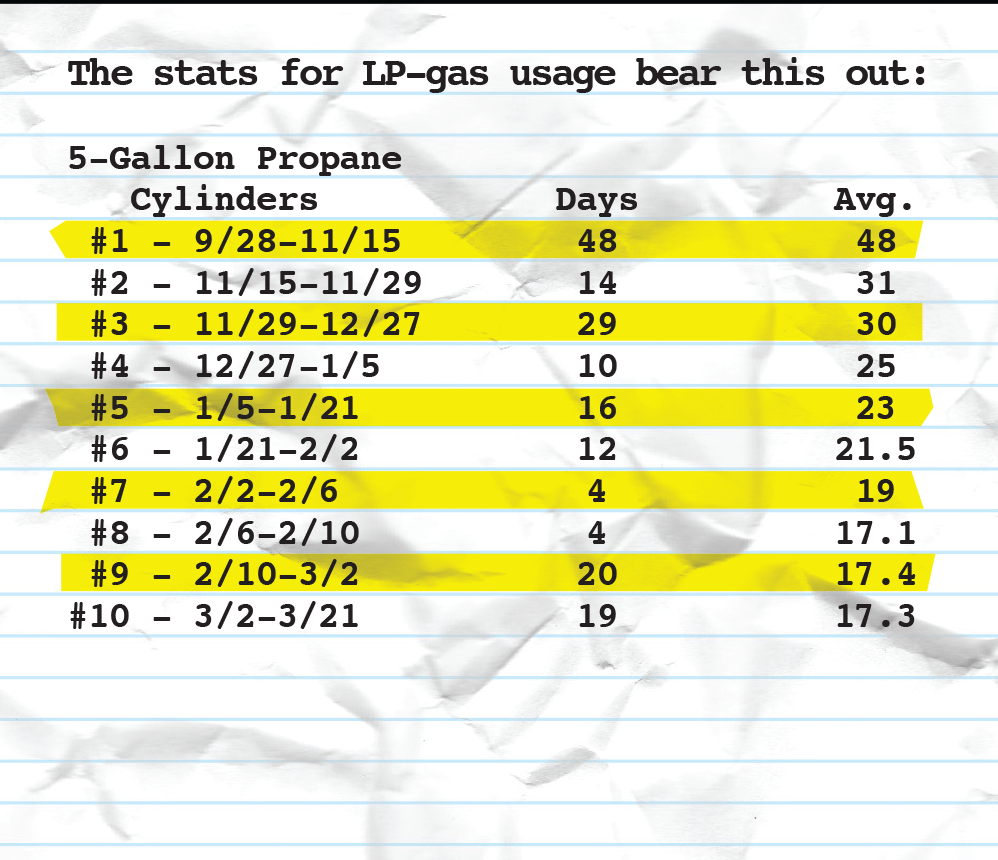
Of course, having three energetic little grandkids just 32 kilometers (about 20 miles) away helped. In fact, they made the trailer more of a safe haven than anything else. “Peace and quiet” became my mantra, since there was none of it at their house in Riverdale but plenty at Takhini Hot Springs, which we renamed Walden Pond because, like Thoreau, I was the only inhabitant for most of the winter. My solitude was disturbed only a few times by lost snowbirds from Alaska who wandered through like frozen zombies in search of the sun.
Finally, after the balmy December, the first minus-30- degree C morning arrived with the full moon — coincidentally, on my birthday. I was pleased to learn the burn ratio was only 1.5:1, or four minutes of furnace for six minutes of warmth, which projected to 1:1 for minus-35 degrees C and minus-40 degrees C, if it ever got that cold. Temperatures as low as minus-40 degrees C are quite common for the majority of the Yukon but unusual for Whitehorse, which is known as the Banana Belt because it is only 100 miles, as the raven flies, from the Pacific Ocean, which kisses the shore of Skagway, Alaska, and sends warm air over the mountains to the Yukon plateau. It also sends the heaviest snowfalls in North America, but most of that drops out before reaching Whitehorse.
However, at minus-30 degrees C on my birthday morning, I quickly discarded my boxers for long johns, pulled on wool socks and bought a hoodie for my bald spot. The coldest temps always come on clear days because, in northern Canada, winter clouds are a sign of warmth and, usually, snow.
Once past the Solstice, the forces of darkness are no longer much of a threat, as the sun comes back in a hurry in late January and February, and cold snaps are like a bully losing his bluster, but there are still demons out there waiting to ambush the unwary before the freedom of spring and the frivolity of summer.
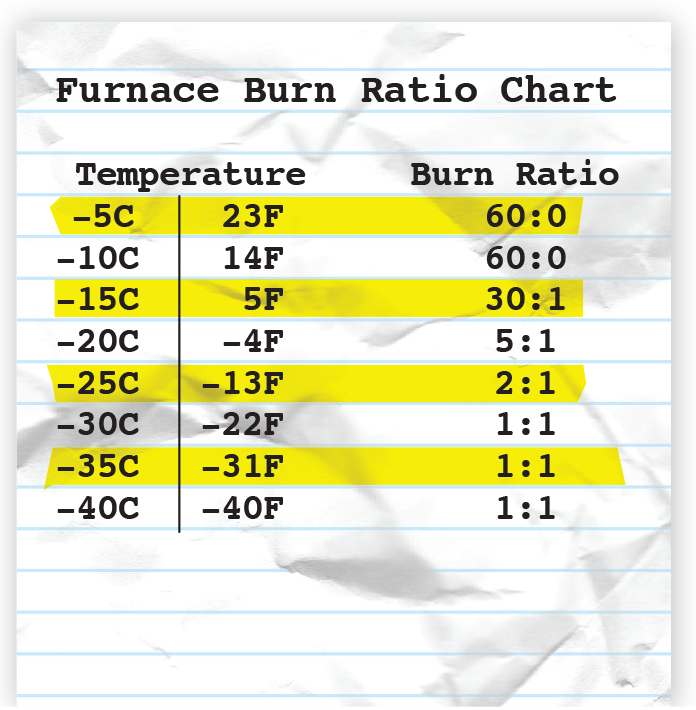
After the five-day cold snap to open 2015, January laid down like an exhausted old man, and we had what amounted to a 16-day chinook, as temperatures climbed near zero, and the snow held off until January 21 when a good foot of angel dust rolled in from Skagway and blanketed southern Yukon with a wet, heavy dump perfect for building snow sculptures and igloos. Finally, I had enough free insulation to complete the iglooization of the trailer, just in time for the third cold snap of the winter, which arrived like a freight train overnight on January 26 and 27.
But this time I was prepared for it and even felt a bit disdainful and disrespectful after nearly three weeks of balmy temps. The temperature went south of minus-20 degrees C on January 26, peaked at minus-33 degrees C and stayed there until February 11. It lasted 16 days, karmic retribution, but there was some relief in the late afternoons as the sun started climbing higher and higher over the southern mountains. After February 1, the sun started coming back like a tsunami of daylight, the days quickly lengthened, and I started to think I could smell spring, even with a plugged nose and a weak imagination. Some people say beating a Yukon winter is just a game of mind over matter, but I’m not that philosophical after three months of darkness.
It’s All About the Sun
I think it’s all about the sun, or the lack of same. I’m a dedicated sun worshipper, and there just isn’t anything to worship on both sides of the Solstice, which is why I love February and loathe November. November sucks the last of the life out of a dying sun, but February gives it back. It might be the shortest and quickest month of the year, but it plays huge every year in the annual battle against the forces of darkness and evil. February wears winter down, then March kicks it in the butt, and April, the joker or fool’s month, makes a mess of everything with spring runoff, which is actually just the tears of a dying winter melting away like the Wicked Witch of the North in The Wizard of Oz.
Then February warmed up again at the end, and winter died as suddenly as the Seahawks in the Super Bowl. Before the Equinox on March 20, I was pulling off the skirting and preparing the R-pod for spring camping and summer gold mining. All I had to do to win the game was to turn my little R-pod trailer into an igloo.
Igloo Camping
Will I ever do it again? Probably not: Been there, done that, got the T-shirt. This winter I want to be farther south, but I haven’t decided yet whether to spend it in Homer, Alaska, or Haida Gwaii, British Columbia. Both are on the ocean, south of the St. Elias Mountains, isolated and frost-free.
I’ll either flip a coin to make the call or just follow the radiator cap and see where it leads me.
And, finally, it helped that the winter of 2014 and 2015 was the warmest in the history of recorded Alaskan and Yukon weather…but that’s another story.

